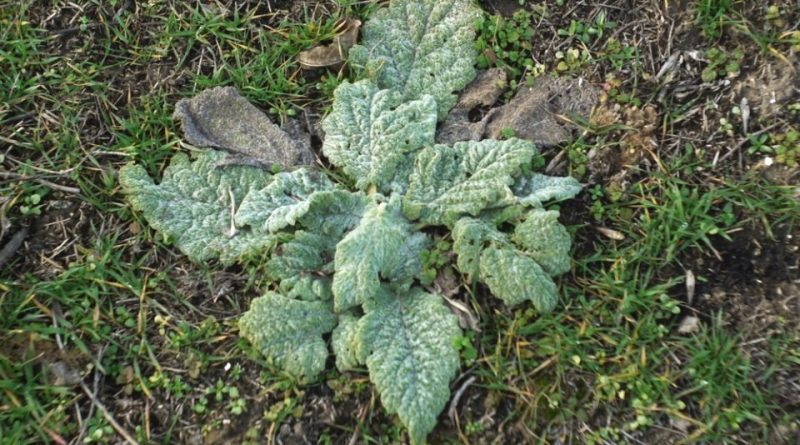Salvia aethiopis
Salvia aethiopis
The mediterranean sage (Salvia aethiopis L., 1753) is a perennial herbaceous aromatic species belonging to the Lamiaceae family.
Systematics –
From a systematic point of view, it belongs to the Eukaryota Domain, Kingdom Plantae, Sub-Trinchebionta Subdivision, Spermatophyta Superdivision, Magnoliophyta Division, Magnoliopsida Class, Asteridae Subclass, Lamiales Order, Lamiaceae Family, Mentheae Tribe and then to the genus Salvia.
The terms are frequent:
– Aethiopis vera Fourr .;
– Salvia idanensis Ghent .;
– Sage kochiana Kunze;
– Salvia lanata Stokes;
– Salvia leuconeura Boiss .;
– Sclarea aethiopis (L.) Mill .;
– Sclarea lanata Moench.
Etymology –
The term Salvia is the name already used by Pliny for the Salvia officinalis, from sálvo to save, to heal (connected with the Sanskrit sárvas integral): for its officinal properties.
The specific epithet aethiopis is the genitive of aethiops, coming in turn from the Greek Αἰϑίοψ Aithíops Ethiopian (from αἰϑός aithós burned, blackish, brown and from ὄψις ópsis volto, aspect), a term referring to color populations and therefore to Africans, in particular to the inhabitants of present-day Ethiopia: with reference to African origin.
Geographical Distribution and Habitat –
Mediterranean sage has an area of distribution in the Mediterranean area, including Transcaucasia and Anatolia.
In Italy it is a rare species and we find it only in Piedmont and in the Valle d’Aosta. Outside of Italy it is in France (departments of Alpes-de-Haute-Provence, Hautes-Alpes, Drôme and Savoy).
It is also present on other European reliefs connected to the Alps, such as in the Massif Central, the Balkan Mountains and the Carpathians.
Outside the Mediterranean it can become a weed that can settle permanently in the dry pastures of North America or in other regions of the world.
Its habitat is that of dry pastures and stony, arid places, on calcareous but also siliceous substrates with neutral pH and high nutritional values of the soil.
The altimetric distribution is from 100 up to 1.000 m s.l.m ..
Description –
The Salvia aethiopis is a small perennial herbaceous species with a height between 40 and 100 cm. The plant is white-woolly; but not viscous, with secondary rhizome roots (the rhizome can be very large and branched).
The stem is erect, with a quadrangular section, with regularly arched branches.
The leaves are basal at the opposite disposition collected in a rosette, with oval and petiolate shaped foil. The length of the petiole is 3 – 10 cm and the blade is 3 – 8 cm wide and 9 – 16 cm long.
The edges are irregularly and coarsely serrated.
The flowers are hermaphroditic, zygomorphic, tetracyclic and pentamers with a length of 12 – 18 mm, collected in axillary inflorescences formed by superimposed and spaced 4 to 6 flowers vertically subtended by reniform bracts with the apex remaining; the bracts are shorter than the calyx and corolla. The length of the floral bracts is 6 – 8 mm.
The fruit is a tetrachenium with a more or less ovoid shape and with very small dark brown seeds, without endosperm.
Pollination is entomophilous, through dipterans and Hymenoptera, rarely Lepidoptera or Ornithogam.
The anthesis is in the spring period.
Cultivation –
For the cultivation of Salvia aethiopis it is necessary to choose soils with neutral pH, also poor but with excellent drainage.
The plant can be sown with a broad spread and is tolerant to cold, being able to withstand up to –12 ° C.
The exposure must be in full sun and the irrigation required in the period between mid-spring and late summer.
Being a perennial plant, it also reproduces by scattering the seeds that fall to the ground (after having been transported a few meters from the wind – anemocora dissemination) and then dispersed mainly by insect-like insects (mirmecoria dissemination).
Uses and Traditions –
The mediterranean sage despite being an aromatic plant has no particular uses where it is widespread. In non-European areas it tends to become a pest in dry pastures, so that it must be fought with weeding techniques.
The Phrydiuchus tau weevil is used where biological control is applied.
This insect digs up to the crown of the root where it feeds and develops. The adults feed on the foliage, but most of the damage to the plant is caused by the feeding activity of the larva.
Preparation Mode –
There are no known uses of this plant in the food or pharmaceutical field even though, due to the presence of aromatic substances, many species of this family are used in the kitchen as a condiment, in perfumery, liqueur and pharmacy.
Guido Bissanti
Sources
– Acta Plantarum – Flora of the Italian Regions.
– Wikipedia, the free encyclopedia.
– Treben M., 2000. Health from the Pharmacy of the Lord, Advice and experiences with medicinal herbs, Ennsthaler Editore
– Pignatti S., 1982. Flora of Italy, Edagricole, Bologna.
– Conti F., Abbate G., Alessandrini A., Blasi C. (edited by), 2005. An annotated checklist of the Italian vascular flora, Palombi Editore.
Attention: Pharmaceutical applications and food uses are indicated for informational purposes only, do not in any way represent a medical prescription; therefore no responsibility is assumed for their use for curative, aesthetic or food purposes.


